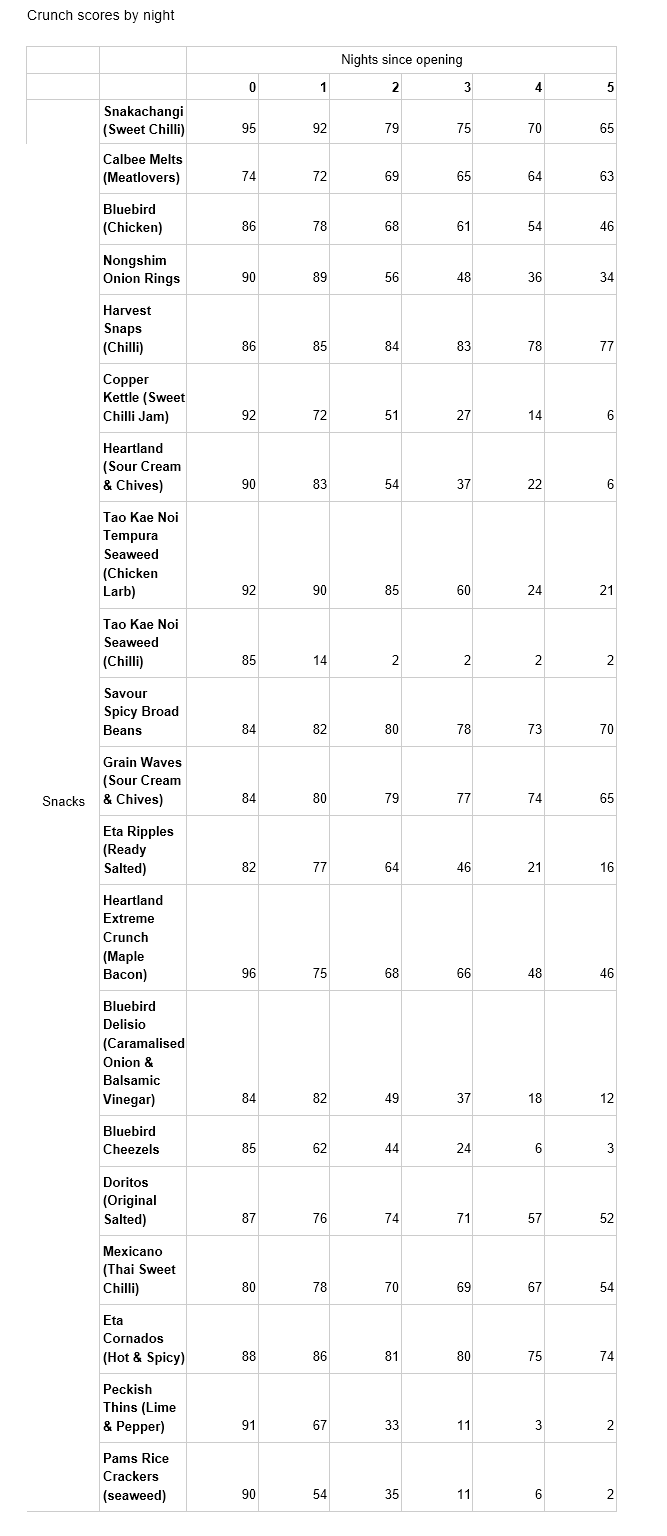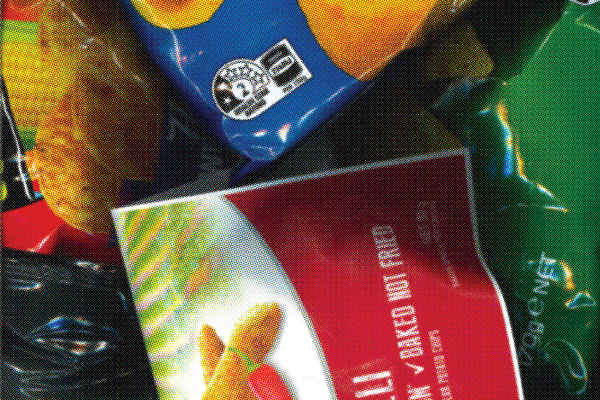Abstract
This study was designed to address the common problem of post-party stale-chippery. Our results suggest that corn- versus potato-based chips de-crunchify at variable rates, and indicate that the safest snacks to leave open overnight are Harvest Snaps, Cornados, Snakachangi chips, Grain Waves, and Savour Spicy Broad Beans. This data will hopefully inform the vulnerable consumer base that is the student body, allowing them to plan their chip consumption according to their unpredictable lifestyle.
Introduction
Modern students are burdened by a variety of choice in the chip aisle. With so many options, many feel overwhelmed by indecision, though Rebollar et al. (2017) have shown that chip packaging advertising crunchiness encourages purchase rates, clearly highlighting the importance of the crunch factor.
We connected this plight to another common struggle: that of the de-crunchified chip, one left open after a big night out. The scenario usually goes as follows: the student thoughtfully purchases a savoury snack to consume later that night, before becoming inebriated, enjoying a night of revelry and hooliganism, failing to find a “mate” to spend the night with, and going back to bed to watch Netflix and consume the savoury snack purchased earlier. As the student is drunk beyond reproach, they fall asleep with the half eaten bag of chips by their bedside - with not a Chip Clip in sight. The following morning, is the savoury snack still crunchy and edible, or is it stale and soft? What about the following day? Does it depend on the snack? Yes, yes, and yes.
Seeing as recent studies have suggested that chip crunchiness can inspire a higher consumption rate (Cahayadi, 2020), this study aimed to evaluate the crunch of various savoury snacks over time using a sophisticated CrunchScore™ analysis. We hypothesised that every snack will get less crunchy over time, although at different rates across brands and ingredient types.
Methodology
An assortment of savoury snacks were purchased from a local supermarket for exorbitant prices. Eight were potato-based chips, five were corn-based snacks, and seven were made from other foodstuffs such as rice, peas, or seaweed. Cashiers were told: “I swear these are not all for me.” This was a lie. Taste and smell were not considered important factors, and only crunch was included in the analysis. The authors note that, as pointed out by Duizer (2001), perceived chip crunchiness is significantly impacted by the auditory sensation of mastication, not purely the physical mouth-feel. We accepted these conclusions and then proceeded to ignore them.
Snacks were opened on a coffee table and sampled immediately, then sampled every morning over the next five days. After each sampling, the snack was given a CrunchScore™ out of 100. Anything under 50 was considered completely inedible, though this variable is dependent on personal preference.
Results
Upon initial tasting, as expected, all snacks were highly crunchy. Heartland Extreme Crunch (Maple Bacon) lived up to the name, scoring the highest initial CrunchScore™ followed closely by Snakachangi (Sweet Chilli). Calbee Melts (Meatlovers) were a first try for the researchers. The bag was significantly heavier than the other chip bags which was both exciting and disconcerting. The chips looked a little gross, sort of like an industrial accident, but honestly slapped. However, their crunch rating was lowered by the added layer of cheese.
By and large, the first night saw little decline in crunchiness across the board, indicating that the morning immediately following a bag-left-open scenario is still within the prime snacking window. There were, however, significant drops in crunchiness for various kettle chips, Cheezels and, most significantly, Tao Kae Noi Seaweed (Chilli). The Onion Rings did not lose much crunch but did smell and taste more oniony.
Further loss of crunch was witnessed across the rest of the timeframe at varying rates, though the most important datapoint was morning one, as this is when the chip-consumer is at their most vulnerable. The crunch-time curve is shown for potato chips in Figure 1, corn-based snacks in Figure 2, and all other snacks in Figure 3, which all present the CrunchScore™ of each snack over the five nights since they were opened.
Discussion
As seen in Figure 1, amongst the potato chips, the kettle chips (Copper Kettle, Heartland Extreme Crunch, and Bluebird Delicio) have some of the biggest initial crunches but appear to lose their crunch most rapidly. Snakachangi chips lost the least amount of crunch out of the potato chips.
As seen in Figures 1 and 2, corn-based snacks held onto their crunch better than potato-based snacks overall with the exception of Bluebird Cheezels, which became hard and chewy after one night and continued to lose crunchiness from there. We propose this is due to the milk products present in Cheezels, although further research is needed to investigate this.
Snacks that were not potato- or corn-based varied significantly in crunchiness over time, as seen in Figure 3. Rice-based crackers (Peckish Thins, Pams Rice Crackers) decreased in CrunchScore™ after one night, while Harvest Snaps (Chilli) and Savour Spicy Broad Beans maintained a high CrunchScore™. While the Tao Kae Noi Seaweed (Chilli) became floppy after one night, the Tao Kae Noi Tempura Seaweed (Chicken Larb) sustained crunchiness throughout the experiment.
Limitations of this study included: inconsistent humidity and temperature control, possible human error and bias in sampling consistency, lack of data replication, too many sweet chilli flavoured things, and a gaping lack of Arnott’s Shapes.
Conclusion
As seen in figure 4, Harvest Snaps (Chilli) and Eta Cornados (Hot & Spicy) held the highest total CrunchScores™ across the five nights, as well as the highest CrunchScores™ at the final tasting. This was followed by Snakachangi (Sweet Chilli), Savour Spicy Broad Beans, and Grain Waves (Sour Cream & Chives). Overall, corn-based snacks lasted longer than potato- or rice-based snacks but this was not a comprehensive rule. Eta Cornados scared the researchers a little before this experiment and these results have made the researchers even more scared.
Works Cited
Cahayadi, Jimmy; Leong, Sze Ying; Oey, Indrawati; and Peng, Mei. 2020. "Textural Effects on Perceived Satiation and Ad Libitum Intake of Potato Chips in Males and Females". Foods Volume 9, no. 1: 85. https://doi.org/10.3390/foods9010085
Duizer, Lisa. 2001. “A review of acoustic research for studying the sensory perception of crisp, crunchy and crackly textures”. Trends in Food Science & Technology. Volume 12, no. 1: 17-24.
Rebollar, Rubén; Gil, Ignacio; Lidón, Iván; Martín, Javier; Fernández, María J.; Rivera, Sandra. 2017. “How material, visual and verbal cues on packaging influence consumer expectations and willingness to buy: The case of crisps (potato chips) in Spain.” Food Research International. Volume 99, 239-246.
Tables and figures:
CrunchScore™ over time, split into snack-type.
FIGURE 1
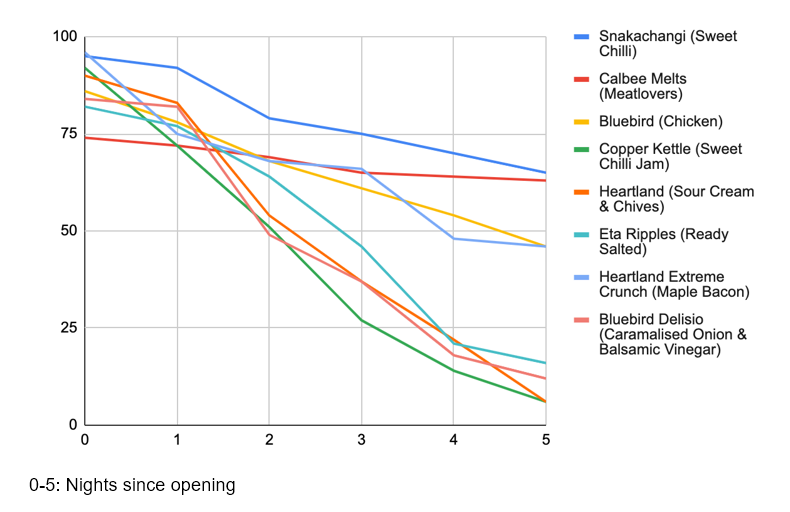
FIGURE 2
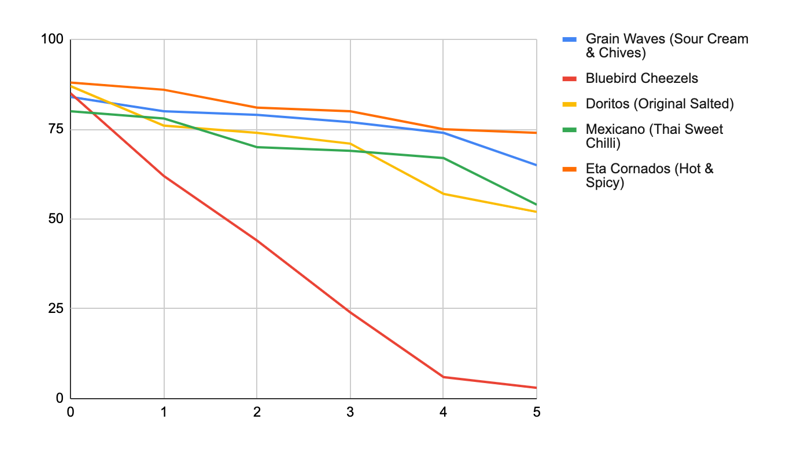
FIGURE 3
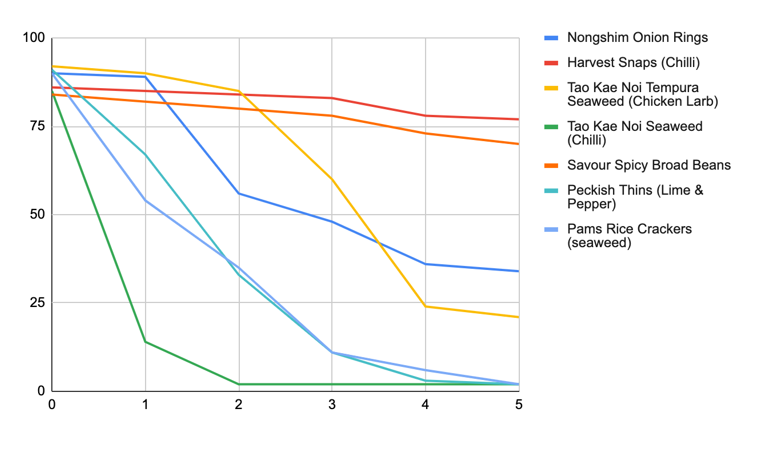
Total CrunchScore™ over time
FIGURE 4
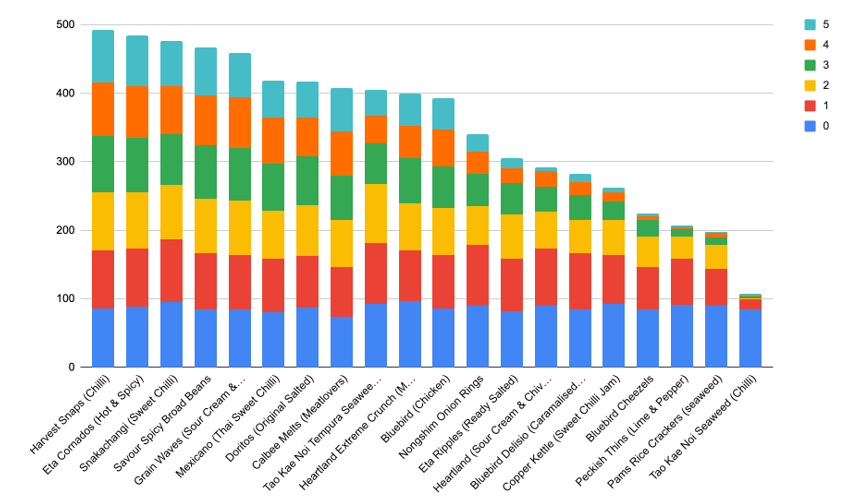
Crunch scores by night
